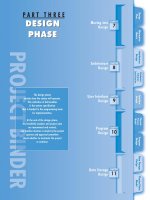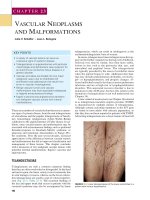Ebook Textbook of diagnostic microbiology (5th edition): Part 1
Bạn đang xem bản rút gọn của tài liệu. Xem và tải ngay bản đầy đủ của tài liệu tại đây (17.74 MB, 548 trang )
tahir99 VRG
YOU’VE JUST PURCHASED
MORE THAN
A TEXTBOOK!
Evolve Student Resources for Mahon, Lehman and
Manuselis: Textbook of Diagnostic Microbiology, 5th Edition,
include the following:
• Laboratory Manual
Activate the complete learning experience that comes with each
textbook purchase by registering at
/>REGISTER TODAY!
You can now purchase Elsevier products on Evolve!
Go to evolve.elsevier.com/html/shop-promo.html to search and browse for products.
Evolve Student Resources are provided free with each book purchase only.
tahir99 VRG
Textbook of
Diagnostic
Microbiology
tahir99 VRG
This page intentionally left blank
tahir99 VRG
Textbook of
Diagnostic
Microbiology
FIFTH EDITION
Connie R. Mahon, MS
Director, Staff and Organization Development
Health Resources and Services Administration
HIV/AIDS Bureau
Rockville, Maryland
Adjunct Faculty
Department of Clinical Research and Leadership
School of Medicine and Health Sciences
George Washington University
Washington, DC
Donald C. Lehman, EdD, MT(ASCP),
SM(NRM)
Associate Professor
Department of Medical Laboratory Sciences
University of Delaware
Newark, Delaware
George Manuselis, MA, MT(ASCP)
Emeritus
Medical Technology Division
Ohio State University
Columbus, Ohio
Adjunct Faculty
Department of Natural Sciences and Forensic Science
Central Ohio Technical College
Newark, Ohio
tahir99 VRG
3251 Riverport Lane
Maryland Heights, Missouri 63043
TEXTBOOK OF DIAGNOSTIC MICROBIOLOGY,
FIFTH EDITION
ISBN: 978-0-323-08989-0
Copyright © 2015 Saunders, an imprint of Elsevier, Inc.
All rights reserved. No part of this publication may be reproduced, stored in a retrieval system, or transmitted,
in any form or by any means, electronic, mechanical, photocopying, recording, or otherwise, without written
permission of the publisher. Details on how to seek permission, further information about the Publisher’s
permissions policies and our arrangements with organizations such as the Copyright Clearance Center and the
Copyright Licensing Agency, can be found at our website: www.elsevier.com/permissions.
This book and the individual contributions contained in it are protected under copyright by the Publisher
(other than as may be noted herein).
Notices
Knowledge and best practice in this field are constantly changing. As new research and experience
broaden our understanding, changes in research methods, professional practices, or medical treatment may
become necessary.
Practitioners and researchers must always rely on their own experience and knowledge in evaluating
and using any information, methods, compounds, or experiments described herein. In using such
information or methods they should be mindful of their own safety and the safety of others, including
parties for whom they have a professional responsibility.
With respect to any drug or pharmaceutical products identified, readers are advised to check the most
current information provided (i) on procedures featured or (ii) by the manufacturer of each product to be
administered, to verify the recommended dose or formula, the method and duration of administration, and
contraindications. It is the responsibility of practitioners, relying on their own experience and knowledge
of their patients, to make diagnoses, to determine dosages and the best treatment for each individual
patient, and to take all appropriate safety precautions.
To the fullest extent of the law, neither the Publisher nor the authors, contributors, or editors, assume
any liability for any injury and/or damage to persons or property as a matter of products liability,
negligence or otherwise, or from any use or operation of any methods, products, instructions, or ideas
contained in the material herein.
The views and opinions of contributors to the Work who are employees of the National Institutes of
Health, Department of Defense, or other Departments of the U.S. Government do not necessarily state or
reflect those of the U.S. Government, nor does the NIH, Department of Defense, or the U.S. Government
endorse, warrant, or guarantee the information contained therein.
Previous editions copyrighted 2011, 2007, 2000, 1995
Library of Congress Cataloging-in-Publication Data
Textbook of diagnostic microbiology / [edited by] Connie R. Mahon, Donald C. Lehman,
George Manuselis.—Fifth edition.
p. ; cm.
Includes bibliographical references and index.
ISBN 978-0-323-08989-0 (hardcover)
I. Mahon, Connie R., editor of compilation. II. Lehman, Donald C., editor of
compilation. III. Manuselis, George, editor of compilation.
[DNLM: 1. Microbiological Techniques. 2. Bacterial Infections--diagnosis. 3. Communicable
Diseases—diagnosis. 4. Mycoses—diagnosis. 5. Virus Diseases—diagnosis. QW 25]
QR67
616.9′041—dc23
2013045846
Vice President and Publisher: Andrew Allen
Managing Editor: Ellen Wurm-Cutter
Content Development Specialist: Amy Whittier
Publishing Services Manager: Julie Eddy
Project Managers: Celeste Clingan/Nisha Selvaraj/Devendran Kannan
Design Direction: Karen Pauls
Printed in China
Last digit is the print number: 9 8 7 6 5 4 3 2 1
tahir99 VRG
To my husband, Dan, for his love and continued support
and understanding, my son, Sean, who inspires me, my daughter, Kathleen,
for showing me courage, and my granddaughters, Kelly Amelia and Natalie Page,
who have given us so much pleasure.
CRM
To my wife, Terri, who has given me constant support and
encouragement, and whose love makes anything I do possible,
and my parents, Gerald and Sherrie, who have always been proud of
me—even though they have passed away, I know they still look over me.
DCL
To my daughters, Kristina and Shellie, my sisters, Libby and Helen,
and my brother, Demetrious and, in memory of my parents,
Katherine and George, for their love and encouragement.
GM
tahir99 VRG
This page intentionally left blank
tahir99 VRG
Reviewers
Dawn Nelson, MA, MT(ASCP)
Director of Medical Laboratory Technology Program
Florence Darlington Technical College
Florence, South Carolina
Daniel deRegnier, MS, MT(ASCP)
Associate Professor
Program Director of Clinical Laboratory Science
Ferris State University
Big Rapids, Michigan
Jennifer Sanderson, MS, MLS(ASCP)
Curriculum Consultant
Siemans Healthcare Diagnostics
Wilmington, Delaware
Delfina Dominguez, MT(ASCP), MS, PhD
Professor
University of Texas at El Paso
El Paso, Texas
Lynne Steele, MS, MLS(ASCP)
Chair and Professor
Medical Laboratory Technology and Phlebotomy
Oakton Community College
Des Plaines, Illinois
Frances Pouch Downes, HCLD(ABB), PhD
Professor
Biomedical Laboratory Diagnostics Program
Michigan State University
East Lansing, Michigan
Ron Walker, MBA, CNMT, PET
Professor
The University of Findlay
Findlay, Ohio
Shawn Froelich, MLS(ASCP)
Adjunct Instructor of Medical Laboratory Sciences
Allen College
Waterloo, Iowa
Karen Golemboski, Ph.D., MLS(ASCP)
Associate Professor
Medical Laboratory Science
Bellarmine University
Louisville, Kentucky
Amy Kapanka, MS, MT(ASCP)SC
Director, Medical Laboratory Technology Program
Hawkeye Community College
Waterloo, Iowa
Michael Majors, BS, MLS(ASCP)
Microbiology Technical Specialist
Providence Sacred Heart Medical Center and Children’s Hospital
Spokane, Washington
Nicholas Moore, MS, MLS(ASCP)
Laboratory Director
Kindred Healthcare, Inc.
Kindred Hospital Chicago
North Chicago, Illinois
Mildred K. Fuller, PhD, MT(ASCP)
Former Department Chair, Allied Health
Medical Technology Program
Norfolk State University
Norfolk, Virginia
Lori A. Woeste, EdD
Assistant Dean and Associate Professor
College of Applied Science and Technology
Illinois State University
Normal, Illinois
tahir99 VRG
vii
This page intentionally left blank
tahir99 VRG
Contributors
Annette W. Fothergill, MA, MBA, MT(ASCP), CLS(NCA)
Assistant Professor
Department of Pathology
Technical Director, Fungus Testing Lab
University of Texas Health Science Center at San Antonio
San Antonio, Texas
Wade K. Aldous, PhD(ABMM)
Chief, Microbiology
Department of Clinical Support Services
U.S. Army Medical Department Center and School
Fort Sam Houston, Texas
Carl Brinkley, PhD
Department of Chemistry and Life Science
Colonel United States Military Academy
West Point, New York
Gerri S. Hall, PhD, D(ABMM), F(AAM)
Retired as Medical Director in Clinical Microbiology
Forestville, New York
Maximo O. Brito, MD, FACP
Assistant Professor of Medicine
Vice Chair for Urban Global Health, Department of Medicine
Director, Infectious Diseases Fellowship Training Program
Chief of Infectious Diseases Fellowship, Jesse Brown VA
Medical Center
Division of Infectious Diseases
University of Illinois at Chicago
Chicago, Illinois
Nina M. Clark, MD
Associate Professor of Infections Disease
Department of Medicine
Division of Infectious Diseases
Medical Director, Transplant Infectious Diseases
Loyola University Medical Center
Maywood, Illinois
Christopher Hatcher, MS, M(ASCP)
Major, United States Army
Army Medical Department Student Detachment
Fort Sam Houston, Texas
Michelle M. Jackson, PhD
Senior Microbiologist
U.S. Food and Drug Administration
Center for Drug Evaluation and Research
Silver Spring, Maryland
James L. Cook, MD
Professor of Infectious Disease
Co-Director, Infectious Disease and Immunology Institute
Loyola University
Maywood, Illinois
Director, Division of Infectious Diseases
Department of Medicine
Loyola University Medical Center
Maywood, Illinois
Chief, Infectious Diseases
Edward Hines Jr. VA Hospital
Chicago, Illinois
Robert C. Fader, PhD, D(ABMM)
Section Chief, Microbiology/Virology Laboratory
Scott and White Memorial Hospital
Baylor Scott & White Health
Assistant Professor
Department of Pathology
Texas A&M University College of Medicine
Temple, Texas
Amanda T. Harrington, PhD, D(ABMM)
Director, Microbiology Service
Assistant Professor, Pathology
University of Illinois at Chicago
Chicago, Illinois
Deborah Ann Josko, PhD
Associate Professor
Director, Medical Laboratory Science Program Rutgers, The State
University of New Jersey
School of Health Related Professions
Newark, New Jersey
Edward F. Keen III, PhD, SM(ASCP)
Major, Medical Service Corps, United States Army
Chief, Microbiology
Department of Pathology and Area Laboratory Services
William Beaumont Army Medical Center
El Paso, Texas
Arun Kumar, PhD
Assistant Professor of Medical Laboratory Sciences
University of Delaware
Newark, Delaware
Donald C. Lehman, EdD, MT(ASCP), SM(NRM)
Associate Professor
Department of Medical Laboratory Sciences
University of Delaware
Newark, Delaware
tahir99 VRG
ix
x
CONTRIBUTORS
Steven D. Mahlen, PhD, D(ABMM)
Director, Clinical and Molecular Microbiology
Affiliated Laboratory, Inc.
Eastern Maine Medical Center
Bangor, Maine
Lester Pretlow, PhD, C(ASCP), NRCC(CC)
Associate Professor and Chair
Department of Medical Laboratory, Imaging, and Radiologic Sciences
Georgia Regents University
Augusta, Georgia
Connie R. Mahon, MS, MT(ASCP), CLS
Microbiologist and Senior Education Program Specialist
Staff College, Center for Veterinary Medicine
U.S. Food and Drug Administration
Rockville, Maryland
Adjunct Faculty
Department of Clinical Laboratory Sciences
School of Medicine and Health Sciences
George Washington University
Washington, DC
Gail E. Reid, MD
Assistant Professor, Medicine
Division of Infectious Diseases
Department of Medicine
Loyola University Medical Center
Maywood, Illinois
George Manuselis, MA, MT(ASCP)
Emeritus
Medical Technology Division
Ohio State University
Columbus, Ohio
Adjunct Faculty
Department of Natural Sciences and Forensic Science
Central Ohio Technical College
Newark, Ohio
Kevin McNabb, PhD, MT(ASCP)
Director, Microbiology and Immunology
New Hanover Regional Medical Center
Wilmington, North Carolina
Frederic J. Marsik, PhD, ABMM
Microbiology Consultant
New Freedom, Pennsylvania
Sarojini R. Misra, MS, SM(NRM), SM(ASCP)
Manager, Microbiology, Immunology, & Virology
University of Delaware
Christiana Care Health Services
Newark, Delaware
Paula C. Mister, MS, MT(ASCP)SM
Educational Coordinator, Medical Microbiology
Johns Hopkins Hospital
Baltimore, Maryland
Linda S. Monson, MS, MT(ASCP)
Microbiologist–Biosafety Officer
DPALS Department of Pathology and Area Lab Services
Brooke Army Medical Center
Fort Sam Houston, Texas
Sumathi Nambiar, MD, MPH
Division of Anti-infective Products
Center for Drug Evaluation and Research
U.S. Food and Drug Administration
Silver Spring, Maryland
Susan M. Pacheco, MD
Staff Physician
Edward Hines, Jr. VA Hospital
Assistant Professor of Infectious Disease
Department of Medicine
Loyola University
Chicago, Illinois
Lauren Roberts, MS, MT(ASCP)
Microbiology Supervisor
St. Joseph’s Hospital & Medical Center
Phoenix, Arizona
Prerana Roth, MD, FACP
Assistant Professor of Medicine
Division of Infectious Diseases
University of Illinois at Chicago
Chicago, Illinois
Barbara L. Russell, EdD, MLS(ASCP)SH
Associate Professor and Program Director
Program of Clinical Laboratory Science
Department of Biomedical and Radiological Technologies
Medical College of Georgia
Augusta, Georgia
Linda A. Smith, PhD, MLS(ASCP)
Professor and Chair
Department of Clinical Laboratory Sciences
The University of Texas Health Science Center
San Antonio, Texas
Kalavati Suvarna, PhD
Microbiologist
Biotech Manufacturing Assessment Branch
Office of Manufacturing and Product Quality
Office of Compliance
Center for Drug Evaluation and Research
U.S. Food and Drug Administration
Rockville, Maryland
Daniel A. Tadesse, DVM, PhD
Research Microbiologist
Division of Animal and Food Microbiology
FDA-CVM
Laurel, Maryland
Kimberly E. Walker, PhD, MT(ASCP)
Manager, Public Affairs
American Society for Microbiology
Washington, DC
A. Christian Whelen, PhD, (D)ABMM
State Laboratories Director
Hawaii Department of Health
Pearl City, Hawaii
tahir99 VRG
CONTRIBUTORS
Shaohua Zhao, DVM, MPVM, PhD
Senior Research Microbiologist
Division of Animal and Food Microbiology
FDA-CVM
Laurel, Maryland
Test Bank Writer
Janice M. Conway-Klaassen, PhD, MT(ASCP)SM
Director, Clinical Laboratory Science Program
University of Minnesota
Minneapolis, Minnesota
PowerPoint Writer
Perry Scanlan, PhD, MT(ASCP)
Associate Professor and Program Director Medical Laboratory
Science Program
Department of Allied Health Sciences
Austin Peay State University
Clarksville, Tennessee
Laboratory Manual Writer
Stephen D. Dallas, PhD, D(ABMM), MT(ASCP)SM
Assistant Director and Assistant Professor of Microbiology
Department of Clinical Laboratory Sciences
San Antonio, Texas
tahir99 VRG
xi
This page intentionally left blank
tahir99 VRG
Preface
W
e welcome you to the fifth edition of the Textbook of
Diagnostic Microbiology.
This edition embodies our commitment to convey
information on the ever-evolving, complex, and challenging field
of diagnostic microbiology. Similar to previous editions, we
remain committed to preserving the tradition of providing a
well-designed and organized textbook. This edition maintains
the building block approach to learning, critical thinking, and
problem solving, features that clinical laboratory science and
clinical laboratory technician students, entry-level clinical laboratory practitioners, and others have found valuable and effective. In response to our readers’ needs, we continue to enhance
these features that have made this textbook user-friendly.
Because the goal of the Textbook of Diagnostic Microbiology
is to provide a strong foundation for clinical laboratory science
students, entry-level practitioners, and other health care professionals, discussions of organisms are limited to those that are
medically important and commonly encountered, as well as new
and re-emerging pathogens. Students and other readers are provided with valuable learning tools to help them sort through the
vast amount of information—background theoretic concepts,
disease mechanisms, identification schemas, diagnostic characteristics, biochemical reactions, and isolation techniques—to
produce clinically relevant results.
In this edition, considerable changes have been made to show
the vital nature of the field of diagnostic microbiology. A discussion on forensic microbiology has been included in Chapter 30,
Agents of Bioterror. The text has been updated to reflect pathogens newly recognized in the past decade, present new applications of immunologic and/or molecular approaches to diagnose
infections and identify infectious agents, and determine antimicrobial resistance in microorganisms. Despite the progress made
and significant advances that have occurred in their control, prevention, and treatment, infectious diseases remain a major threat
to human health. The combined affects of rapid demographic,
environmental, societal, technologic, and climatic changes, as
well as changes in the way we live our lives, have affected the
occurrence of infectious disease. This fifth edition discusses the
continuing spread of infectious diseases and the emerging public
health issues associated with them.
Whereas the recovery of etiologic agents in cultures has
remained the gold standard in microbiology in determining the
probable cause of an infectious disease, the increase in our capabilities for microbial detection and identification can be attributed
to the advances in molecular diagnostic techniques and how they
are applied in clinical laboratories. Extensive biomedical research
has focused on the potential applications of nanotechnology
to medicine—nanomedicine. Chapter 12 has been updated by
incorporating discussions on the use of nanotechnology in drug
delivery systems, and Chapter 39 includes a discussion of biomarkers in the diagnosis of septicemia. The application of matrixassisted laser desorption-ionization time-of-flight (MALDI-TOF)
mass spectrometry in microbial identification has been added to
Chapter 11.
Organization
Part I has remained the backbone of the textbook, providing
important background information, Part II emphasizes the laboratory identification of etiologic agents, and Part III focuses on
the clinical and laboratory diagnoses of infectious diseases at
various body sites—the organ system approach.
Part I presents basic principles and concepts of diagnostic
microbiology, including quality assurance, which provide students with a firm theoretic foundation. Chapters 7 (Microscopic
Examination of Infected Materials) and 8 (Use of Colony Morphology for the Presumptive Identification of Microorganisms)
still play vital roles in this text. These two chapters help students
and practitioners who may have difficulty recognizing bacterial
morphology on direct smear preparations, as well as colony morphology on primary culture plates, develop these skills through
the use of color photomicrographs of stained direct smears and
cultures from clinical samples. These two chapters also illustrate
how microscopic and colony morphology of organisms can aid
in the initial identification of the bacterial isolate. A summary of
the principles of the various biochemical identification methods
for gram-negative bacteria is described in Chapter 9. This chapter
contains several color photographs to help students understand
the principles and interpretations of these important tests.
Part II highlights methods for the identification of clinically
significant isolates. Bacterial isolates are presented based on a
taxonomic approach. Although diseases caused by the organisms
are discussed, the emphasis is on the characteristics and methods
used to recover and identify each group of organisms. Numerous
tables summarize the major features of organisms, and schematic
networks are used to show the relationships and differences
among similar or closely related species. Chapters devoted to
anaerobic bacterial species, medically important fungi, parasites,
and viruses affirm the significance of these agents. Chapter 29
describes viral pathogens, including severe acute respiratory syndrome and the highly pathogenic avian influenza virus. Chapter
31 describes an increasingly complex entity—biofilms. Recently,
it has become evident that microbial biofilms are involved in the
pathogenesis of several human diseases.
The organ system approach in Part III has been the foundation
of the Textbook of Diagnostic Microbiology and provides an
tahir99 VRG
xiii
xiv
PREFACE
opportunity for students and other readers to “pull things
together.” Chapters begin with the anatomic considerations of the
organ system to be discussed and the role of the usual microbiota
found at the particular site in the pathogenesis of a disease.
Before students can recognize the significance of the opportunistic infectious agents they are most likely to encounter, it is important for them to know the usual inhabitants at a body site. The
case studies included in the chapters in Part III enhance problem
solving and critical-thinking skills, and help students apply
knowledge acquired in Parts I and II. The case studies describe
the clinical and laboratory findings associated with the patients,
allowing students opportunities to correlate these observations
with possible etiologic agents. In most cases, the cause of the
illness is not disclosed in the case study; rather, it is presented
elsewhere in the chapter to give students the opportunity to think
the case through.
Pedagogic Features
As with the previous editions, each chapter is introduced by a
Case in Point. These introductory case studies represent an
important pathogen, infectious disease, concept, or principle that
is discussed in the chapter text and is used to introduce the learner
to the main context discussed in the chapter. The Case in Point
is followed by “Issues to Consider.” These are points in a bulleted
format that the learners are asked to think about as they read the
chapter.
New to this edition are the Case Checks, a feature that aims
to reinforce understanding of the content or concept within the
context of the Case in Point at the beginning of the chapter or
case study at the beginning of a section within the chapter. The
Case Check highlights a particular point in the text that intends
to help the learner connect the dots between the content under
discussion, as illustrated by the case study.
To further reinforce learning, identification tables, flow charts,
and featured illustrations have been updated, and new ones have
been added. Learning objectives and a list of key terms are also
found at the beginning of each chapter. The key terms include
abbreviations used in the text; this places abbreviations where
students can easily find them. At the end of each chapter, readers
will find Points to Remember and Learning Assessment Questions to reinforce comprehension and understanding of important
concepts. Points to Remember includes a bulleted list of important concepts that the reader should have learned from reading
the chapter.
This edition of the Textbook of Diagnostic Microbiology, as
in the previous editions, incorporates the expertise of contributors along with elements such as full-color photographs and photomicrographs, an engaging and easy-to-follow design, learning
assessment questions and answers, opening case scenarios,
hands-on procedures, and lists of key terms to strengthen the
learning strategy.
Ancillaries for Instructors
and Students
For this edition, we continue offering a variety of instructor ancillaries specifically geared for this book. For instructors, the Evolve
website includes a test bank in ExamView containing more than
1200 questions. It also includes an electronic image collection
and PowerPoint slides. For students, the Evolve website includes
a laboratory manual.
tahir99 VRG
Connie R. Mahon
Donald C. Lehman
George Manuselis
Acknowledgments
W
e are grateful to all contributing authors, students, and instructors and many other individuals who have made significant
suggestions and invaluable comments on ways to improve this edition.
Connie R. Mahon
Donald C. Lehman
George Manuselis
tahir99 VRG
xv
This page intentionally left blank
tahir99 VRG
Contents
PART I INTRODUCTION TO CLINICAL
MICROBIOLOGY
1 Bacterial Cell Structure, Physiology, Metabolism,
and Genetics, 2
2 Host-Parasite Interaction, 23
3 The Laboratory Role in Infection Control, 47
4 Control of Microorganisms, 59
5 Performance Improvement in the Microbiology
Laboratory, 93
6 Specimen Collection and Processing, 111
7 Microscopic Examination of Materials from
Infected Sites, 126
8 Use of Colony Morphology for the Presumptive
Identification of Microorganisms, 169
9 Biochemical Identification of Gram-Negative
Bacteria, 181
10 Immunodiagnosis of Infectious Diseases, 198
11 Applications of Molecular Diagnostics, 226
12 Antimicrobial Agent Mechanisms of Action and
Resistance, 254
13 Antimicrobial Susceptibility Testing, 274
PART II LABORATORY IDENTIFICATION
OF SIGNIFICANT ISOLATES
14 Staphylococci, 314
15 Streptococcus, Enterococcus, and Other
Catalase-Negative, Gram-Positive Cocci, 328
16 Aerobic Gram-Positive Bacilli, 349
17 Neisseria Species and Moraxella catarrhalis, 372
18 Haemophilus and Other Fastidious Gram-Negative
Bacilli, 390
19 Enterobacteriaceae, 420
20 Vibrio, Aeromonas, Plesiomonas, and Campylobacter
Species, 455
21 Nonfermenting and Miscellaneous Gram-Negative
Bacilli, 474
22 Anaerobes of Clinical Importance, 495
23 The Spirochetes, 529
24 Chlamydia, Rickettsia, and Similar Organisms, 537
25 Mycoplasma and Ureaplasma, 552
26 Mycobacterium tuberculosis and Nontuberculous
Mycobacteria, 563
27 Medically Significant Fungi, 589
28 Diagnostic Parasitology, 625
29 Clinical Virology, 688
30 Agents of Bioterror and Forensic Microbiology, 727
31 Biofilms: Architects of Disease, 752
PART III LABORATORY DIAGNOSIS OF
INFECTIOUS DISEASES: AN ORGAN
SYSTEM APPROACH TO
DIAGNOSTIC MICROBIOLOGY
Upper and Lower Respiratory Tract Infections, 765
Skin and Soft Tissue Infections, 804
Gastrointestinal Infections and Food Poisoning, 835
Infections of the Central Nervous System, 854
Bacteremia and Sepsis, 868
Urinary Tract Infections, 884
Genital Infections and Sexually Transmitted
Infections, 901
39 Infections in Special Populations, 933
40 Zoonotic Diseases, 942
41 Ocular Infections, 955
32
33
34
35
36
37
38
Appendices
A
B
C
D
Selected Bacteriologic Culture Media, 977
Selected Mycology Media, Fluids, and Stains, 994
Answers to Learning Assessment Questions, 997
Selected Procedures, 1019
Glossary, 1026
Index, 1048
tahir99 VRG
xvii
This page intentionally left blank
tahir99 VRG
PART I
Introduction to
Clinical Microbiology
tahir99 VRG
CHAPTER
1
Bacterial Cell Structure, Physiology,
Metabolism, and Genetics
George Manuselis, Connie R. Mahon*
CHAPTER OUTLINE
■ SIGNIFICANCE
■ OVERVIEW OF THE MICROBIAL WORLD
Bacteria
Parasites
Fungi
Viruses
■ CLASSIFICATION/TAXONOMY
Nomenclature
Classification by Phenotypic and Genotypic Characteristics
Classification by Cellular Type: Prokaryotes, Eukaryotes, and
Archaeobacteria
■ COMPARISON OF PROKARYOTIC AND EUKARYOTIC
CELL STRUCTURE
Prokaryotic Cell Structure
Eukaryotic Cell Structure
■ BACTERIAL MORPHOLOGY
Microscopic Shapes
Common Stains Used for Microscopic Visualization
■ MICROBIAL GROWTH AND NUTRITION
Nutritional Requirements for Growth
Environmental Factors Influencing Growth
Bacterial Growth
■ BACTERIAL BIOCHEMISTRY AND METABOLISM
Metabolism
Fermentation and Respiration
Biochemical Pathways from Glucose to Pyruvic Acid
Anaerobic Utilization of Pyruvic Acid (Fermentation)
Aerobic Utilization of Pyruvate (Oxidation)
Carbohydrate Utilization and Lactose Fermentation
■ BACTERIAL GENETICS
Anatomy of a DNA and RNA Molecule
Terminology
Genetic Elements and Alterations
Mechanisms of Gene Transfer
OBJECTIVES
After reading and studying this chapter, you should be able to:
1. Describe microbial classification (taxonomy) and accurately apply the
rules of scientific nomenclature for bacterial names.
2. List and define five methods used by epidemiologists to subdivide
bacterial species.
3. Differentiate between prokaryotic (bacterial and archaeobacteria)
and eukaryotic cell types.
4. Compare and contrast prokaryotic and eukaryotic cytoplasmic and
cell envelope structures and functions.
5. Differentiate the cell walls of gram-positive from gram-negative
bacteria. Explain the Gram stain reaction of each cell wall type.
Describe two other bacterial cell wall types, and give microbial
examples of each.
6. Explain the use of the following stains in the diagnostic
microbiology laboratory: Gram stain, acid-fast stains (Ziehl-Neelsen,
Kinyoun, auramine-rhodamine), acridine orange, methylene blue,
calcofluor white, lactophenol cotton blue, and India ink.
7. List the nutritional and environmental requirements for bacterial
growth, and define the categories of media used for culturing
bacteria in the laboratory.
8. Define the atmospheric requirements of obligate aerobes,
microaerophiles, facultative anaerobes, obligate anaerobes, and
capnophilic bacteria.
9. Describe the stages in the growth of bacterial cells.
10. Explain the importance of understanding microbial metabolism in
clinical microbiology.
11. Differentiate between fermentation and oxidation (respiration).
12. Name and compare three biochemical pathways that bacteria use to
convert glucose to pyruvate.
13. Identify and compare the two types of fermentation that explain
positive results with the methyl red or Voges-Proskauer test.
14. Define the following genetic terms: genotype, phenotype,
constitutive, inducible, replication, transcription, translation, genome,
chromosome, plasmids, insertion sequence (IS) element, transposon,
point mutations, frame-shift mutations, and recombination.
15. Discuss the development and transfer of antibiotic resistance in
bacteria.
16. Differentiate among the mechanisms of transformation, transduction,
and conjugation in the transfer of genetic material from one
bacterium to another.
17. Define the terms bacteriophage, lytic phage, lysogeny, and
temperate phage.
18. Define the term restriction endonuclease enzyme, and explain the
use of such enzymes in the clinical microbiology laboratory.
*My comments are my own and do not represent the view of Health Resources
and Services Administration of the Department of Health and Human Services.
2
tahir99 VRG
CHAPTER 1 Bacterial Cell Structure, Physiology, Metabolism, and Genetics
Case in Point
A 4-year-old girl had presenting symptoms of redness, burning,
and light sensitivity in both eyes. She also complained of her
eyelids sticking together because of exudative discharge. A Gram
stain of the conjunctival exudates (product of acute inflammation with white blood cells and fluid) showed gram-positive
intracellular and extracellular, faint-staining, coccobacillary
organisms. The organisms appeared to have small, clear, nonstaining “halos” surrounding each one. This clear area was
noted to be between the stained organism and the amorphous
(no definite form; shapeless) background material. The Gram
stain of the stock Staphylococcus (gram-positive) and Escherichia
coli (gram-negative) showed gram-positive reactions for both
organisms on review of the stained quality control organisms.
Issues to Consider
After reading the patient’s case history, consider:
■ The role of microscopic morphology in presumptive
identification
■ Significance of observable cellular structures
■ Importance of quality control in assessing and interpreting
direct smear results
■ Unique characteristics of organisms, such as cellular structure and metabolic and physiologic pathways, in initiating
infection and disease in hosts
Key Terms
Acid-fast
Aerotolerant anaerobes
Anticodon
Archaea
Archaeobacteria
Autotrophs
Bacteria
Bacteriophage
Capnophilic
Capsule
Codon
Competent
Conjugation
Differential media
Dimorphic
Eukarya
Eukaryotes
Facultative anaerobes
Family
Fermentation
Fimbriae
Flagella
Fusiform
Genotype
Genus
Gram-negative
Gram-positive
Heterotrophs
Hyphae
Lysogeny
Mesophiles
Microaerophilic
Minimal medium
Mycelia
Nutrient media
Obligate aerobes
Obligate anaerobes
Pathogenic bacteria
Phenotype
Phyla
Pili
Plasmids
Pleomorphic
Prokaryotes
Protein expression
Psychrophiles
Respiration
Restriction enzymes
Selective media
Species
Spores
Strains
Taxa
Taxonomy
Temperate
Thermophiles
Transduction
Transformation
Transport medium
3
I
n this chapter, the basic concepts of prokaryotic and eukaryotic cells and viral and bacterial cell structure physiology,
metabolism, and genetics are reviewed. Common stains
used to visualize microorganisms microscopically also are presented. The practical importance of each topic to diagnostic
microbiologists in their efforts to culture, identify, and characterize the microbes that cause disease in humans is emphasized.
Proper characterization of the bacterial cells in human samples
is critical in the correct identification of the infecting
organism.
Significance
Microbial inhabitants have evolved to survive in various ecologic
niches (way in which an organism uses its resources) and habitats
(organism’s location and where its resources may be found).
Some grow rapidly, and some grow slowly. Some can replicate
with a minimal number of nutrients present, whereas others
require enriched nutrients to survive. Variation exists in atmospheric growth conditions, temperature requirements, and cell
structure. This diversity is also found in the microorganisms that
inhabit the human body as normal biota (normal flora), as opportunistic pathogens, or as true pathogens. Each microbe has its
own unique physiology and metabolic pathways that allow it to
survive in its particular habitat. One of the main roles of a diagnostic or clinical microbiologist is to isolate, identify, and analyze
the bacteria that cause disease in humans. Knowledge of microbial structure and physiology is extremely important to clinical
microbiologists in three areas:
• Culture of organisms from patient specimens
• Classification and identification of organisms after they have
been isolated
• Prediction and interpretation of antimicrobial susceptibility
patterns
Understanding the growth requirements of a particular bacterium enables the microbiologist to select the correct medium
for primary culture and optimize the chance of isolating the
pathogen. Determination of staining characteristics, based on
differences in cell wall structure, is the first step in bacterial classification. Microscopic characterization is followed by observing
the metabolic biochemical differences between organisms that
form the basis for most bacterial identification systems in use
today. The cell structure and biochemical pathways of an organism determine its susceptibility to various antibiotics.
The ability of microorganisms to change rapidly, acquire new
genes, and undergo mutations presents continual challenges to
diagnostic microbiologists as they isolate and characterize the
microorganisms associated with humans.
Overview of the Microbial World
The study of microorganisms by the Dutch biologist and lens
maker Anton van Leeuwenhoek has evolved immensely from its
early historical beginnings. Because of Leeuwenhoek’s discovery
of what he affectionately called beasties in a water droplet in his
homemade microscope, the scientific community acknowledged
him as the “father of protozoology and bacteriology.”
Today we know that there are enormous numbers of microbes
in, on, and around us in our environment. Many of these microbes
tahir99 VRG
4
PART I Introduction to Clinical Microbiology
do not cause disease. The focus of this chapter and this textbook
is on microbes that are associated with disease.
Bacteria
Bacteria are unicellular organisms that lack a nuclear membrane
and true nucleus. They are classified as prokaryotes (Greek:
before kernel [nucleus]), having no mitochondria, endoplasmic
reticulum (ER), or Golgi bodies. The absence of the preceding
bacterial cell structures differentiates them from eukaryotes.
Table 1-1 compares prokaryotic and eukaryotic cell organization;
Figure 1-1 shows both types of cells.
Parasites
Certain eukaryotic parasites exist as unicellular organisms of
microscopic size, whereas others are multicellular organisms.
Protozoa are unicellular organisms within the kingdom Protista
that obtain their nutrition through ingestion. Some are capable of
TABLE
locomotion (motile), whereas others are nonmotile. They are
categorized by their locomotive structures: flagella (Latin: whiplike), pseudopodia (Greek: false feet), or cilia (Latin: eyelash).
Many multicellular parasites (e.g., tapeworms) may be 7 to
10 meters long (see Chapter 28).
Fungi
Fungi are heterotrophic eukaryotes that obtain nutrients through
absorption. Yeasts are a group of unicellular fungi that reproduce
asexually. “True” yeasts do not form hyphae or mycelia. Most
fungi are multicellular, and many can reproduce sexually and
asexually. The bodies of multicellular fungi are composed of filaments called hyphae, which interweave to form mats called
mycelia. Molds are filamentous forms that can reproduce asexually and sexually. Certain fungi can assume both morphologies
(yeast and hyphae/mycelial forms), growing as yeast at incubator
or human temperature and as the filamentous form at room
1-1 Comparison of Prokaryotic and Eukaryotic Cell Organization
Characteristic
Prokaryote
Eukaryote
Typical size
0.4-2 µm in diameter
10-100 µm in diameter
Nucleus
0.5-5 µm in length
No nuclear membrane; nucleoid region of the
cytosol
>10 µm in length
Classic membrane-bound nucleus
Location
Chromosomal DNA
In the nucleoid, at the mesosome
Circular; complexed with RNA
Genome: extrachromosomal
circular DNA
Plasmids, small circular molecule of DNA
containing accessory information; most
commonly found in gram-negative bacteria;
each carries genes for its own replication; can
confer resistance to antibiotics
Asexual (binary fission)
Absent
Absent in all
Absent in all
Absent in all
Absent in all
Absent in all
Absent in all
Present in all
In the nucleus
Linear; complexed with basic histones and other
proteins
In mitochondria and chloroplasts
Genome
Reproduction
Membrane-bound organelles
Golgi bodies
Lysosomes
Endoplasmic reticulum
Mitochondria
Nucleus
Chloroplasts for photosynthesis
Ribosomes: site of protein synthesis
(nonmembranous)
Size
Electron transport for energy
Sterols in cytoplasmic membrane
Plasma membrane
Cell wall, if present
Glycocalyx
70S in size, consisting of 50S and 30S subunits
In the cell membrane if present; no mitochondria
present
Absent except in Mycoplasma spp.
Lacks carbohydrates
Peptidoglycan in most bacteria
Cilia
Flagella, if present
Present in most as an organized capsule or
unorganized slime layer
Absent
Simple flagella; composed of polymers of
flagellin; movement by rotary action at the
base; spirochetes have MTs
Pili and fimbriae
Present
MT, Microtubule.
tahir99 VRG
Sexual and asexual
All
Present in some
Present in some; contain hydrolytic enzymes
Present in all; lipid synthesis, transport
Present in most
Present in all
Present in algae and plants
Present in all
80 S in size, consisting of 60 S and 40 S subunits
In the inner membrane of mitochondria and
chloroplasts
Present
Also contains glycolipids and glycoproteins
Cellulose, phenolic polymers, lignin (plants),
chitin (fungi), other glycans (algae)
Present; some animal cells
Present; see description of flagella
Complex cilia or flagella; composed of MTs and
polymers of tubulin with dynein connecting
MTs; movement by coordinated sliding
microtubules
Absent
CHAPTER 1 Bacterial Cell Structure, Physiology, Metabolism, and Genetics
5
Division septum
Outer membrane
Peptidoglycan Mesosome
(Capsule) layer
(Pili)
(Capsule)
Cytoplasmic
membrane
Inclusion
body
Inclusion
body
Peptidoglycan
layer
Cytoplasmic
membrane
Ribosome
Ribosome
(Flagellum)
Surface proteins Chromosome
A
GRAM-POSITIVE
Porin
proteins
Periplasmic
space
(Flagellum)
GRAM-NEGATIVE
Centrosome Ribosomes
Centrioles
Smooth
endoplasmic
reticulum
Mitochondria
Smooth endoplasmic
reticulum
Cilia
Mitochondrion
Lysosome
Rough
endoplasmic
reticulum
Free
ribosomes
Peroxisome
B
Golgi
apparatus
Vesicle
Nuclear Nucleus Nucleolus
envelope
FIGURE 1-1 Comparison of prokaryotic and eukaryotic cell organization and structures. A, Prokaryotic gram-positive and gram-negative bacteria. B, Structure of the generalized eukaryotic cell.
(A, From Murray PR, Rosenthal KS, Pfaller MA: Medical microbiology, ed 6, Philadelphia, 2009,
Mosby; B, from Thibodeau GA, Patton KT: Anatomy and physiology, ed 6, St Louis, 2007, Mosby.)
temperature. These fungi are called dimorphic. Some systemic
fungal diseases in human hosts are caused by dimorphic fungi
(see Chapter 27).
Viruses
Viruses are the smallest infectious particles (virions); they cannot
be seen under an ordinary light microscope. They are neither
prokaryotic nor eukaryotic. Many times we can see their effects
on cell lines, such as inclusions, rounding up of cells, and syncytium (cell fusion of host cells into multinucleated infected
forms), where these characteristics become diagnostic for many
viral diseases. They are distinguished from living cells by the
following characteristics:
• Viruses consist of deoxyribonucleic acid (DNA) or ribonucleic acid (RNA), but not both. Their genome may be doublestranded DNA (dsDNA), single-stranded DNA (ssDNA),
double-stranded RNA (dsRNA), or single-stranded RNA
(ssRNA).
• Viruses are acellular (not composed of cells), lack cytoplasmic membranes, and are surrounded by a protein coat.
• Viruses are obligate intracellular parasites that require host
cells for replication (increase in number does not involve
mitosis, meiosis, or binary fission) and metabolism. Because
they lack enzymes, ribosomes, and other metabolites, they
“take over” host cell function to reproduce. Growth (increase
in size) does not occur in viruses.
• Viruses are mostly host or host cell specific. For example,
human immunodeficiency virus (HIV) infects T helper lymphocytes, not muscle cells, in humans; other viruses, such as
the rabies virus, can infect dogs, skunks, bats, and humans. A
virus that infects and possibly destroys bacterial cells is
known as a bacteriophage (Greek phage: to eat).
• Viruses are becoming better known by their DNA or RNA
makeup, host disease signs and symptoms, chemical makeup,
geographic distribution, resistance to lipid solvents and detergents, resistance to changes in pH and temperature, and antigenicity (serologic methods). The organization and type
(either DNA or RNA) of genome of the virus, how the virus
replicates, and the virion (a virus outside of a cell) structure
of the virus are used to differentiate virus order, family, and
tahir99 VRG









